Batteries serve a vital role across various industrial applications, from providing backup power for data centers to storing renewable energy. Among the commonly used battery types in these settings are Valve Regulated Lead Acid (VRLA), Sealed Maintenance-Free (SMF), and Gel Batteries. It’s imperative to ensure their longevity and peak performance through proper maintenance and care. In this blog, we will discuss seven practical tips on how to extend the life of batteries – VRLA/SMF Industrial and Gel type.
AXESS batteries, characterized by factory-charging, eliminate the variability of charging practices among dealers. This consistency ensures that all batteries are on equal footing. Moreover, AXESS batteries are zero-maintenance, eliminating the need for water or acid top-ups. They also boast impressively extended warranty periods, underscoring the brand’s confidence in its product.
However, it’s important to recognize that the battery’s lifespan is not solely determined by the manufacturer. Rather, it is significantly influenced by how the battery is used. Customers play a pivotal role in determining the longevity of their batteries through their usage and maintenance practices.
For further insights into how customers can play an active role in extending the lifespan of their SMF/VRLA batteries, read on for valuable tips.
1. Ensure Proper Installation
Proper installation is the foundation of battery longevity. When installing VRLA/SMF and Gel batteries, make sure to follow the manufacturer’s guidelines meticulously. This includes ensuring that the batteries are placed on a stable, level surface, and securely fastened. Additionally, make sure that the battery terminals are connected correctly, with the right polarity, and that all connections are tightened appropriately. Proper ventilation is also crucial to prevent overheating.
2. Regularly Inspect for Physical Damage
Regular inspections can help identify physical damage that may compromise the integrity of the battery. Look for signs of corrosion, leakage, or swelling on the battery casing. If you notice any of these issues, it’s essential to address them promptly to prevent further damage or safety hazards. Damaged batteries should be replaced as soon as possible to avoid potential risks.
3. Implement a Maintenance Schedule
Establishing a routine maintenance schedule is essential for the care of your VRLA/SMF and Gel batteries. This schedule should include regular checks of voltage levels, terminal connections, and overall battery health. Monitoring the specific gravity of the electrolyte in VRLA/SMF batteries and the gel level in Gel batteries should also be part of your routine. Maintaining detailed records of these checks will help identify any deviations from normal behavior and allow for timely corrective action.
4. Keep the Batteries Clean
Cleanliness is vital for the proper maintenance of batteries. Dust, dirt, and debris can accumulate on the battery’s surface and terminals, potentially leading to electrical leakage or a drop in performance. Regularly clean the batteries using a soft, dry cloth or a mild solution of water and baking soda to remove accumulated dirt and corrosion. Ensure that the batteries are completely dry before reconnecting them.
5. Proper Charging Practices
Overcharging and undercharging are common reasons for premature battery failure. To extend the life of VRLA/SMF and Gel batteries, it’s crucial to follow proper charging practices. Use the appropriate charger designed for your battery type and size. Avoid overcharging by using a charger with an automatic shutoff feature or a smart charger that can adjust the charging rate based on the battery’s state. Undercharging can also be harmful, so make sure the batteries are fully charged regularly.
6. Temperature Control
Temperature can significantly impact the lifespan of VRLA/SMF and Gel batteries. Extreme heat can accelerate the degradation of the battery’s internal components, while cold temperatures can reduce its capacity. Whenever possible, store and operate batteries within the recommended temperature range specified by the manufacturer. If the environment is challenging, consider using temperature control systems to maintain optimal conditions for your batteries.
7. Perform Regular Capacity Testing
Regular capacity testing helps assess the health and performance of your batteries. By conducting load tests or impedance testing, you can identify if a battery is experiencing a capacity loss or internal damage. Capacity testing can be especially helpful for large battery banks used in critical applications, as it allows you to detect and replace weak batteries before they compromise the overall performance of the system.
Conclusion
VRLA/SMF Industrial and Gel batteries are essential components of various industrial and commercial applications, and their reliability is critical. By implementing the tips mentioned above, you can significantly extend the life of your batteries, reduce downtime, and save on replacement costs. Proper installation, routine maintenance, and adherence to manufacturer guidelines are key to ensuring that your batteries perform optimally and last for years to come.
Remember that safety should always be a priority when handling batteries, and if you are unsure about any maintenance procedures, Get in touch with AAGE Trading through Linkedin or Facebook.



